Starter Replacement 4.3 L Engine
Removal Procedure
- Disconnect the negative battery cable. Refer to Battery Negative Cable Disconnection and Connection .
- Raise and support the vehicle. Refer to Lifting and Jacking the Vehicle in General Information.
- Remove the starter motor mounting bolts.
- Disconnect the positive battery cable and wiring harness from the starter.
- Remove the starter from the vehicle.
Caution: Unless directed otherwise, the ignition and start switch must be in the OFF or LOCK position, and all electrical loads must be OFF before servicing any electrical component. Disconnect the negative battery cable to prevent an electrical spark should a tool or equipment come in contact with an exposed electrical terminal. Failure to follow these precautions may result in personal injury and/or damage to the vehicle or its components.
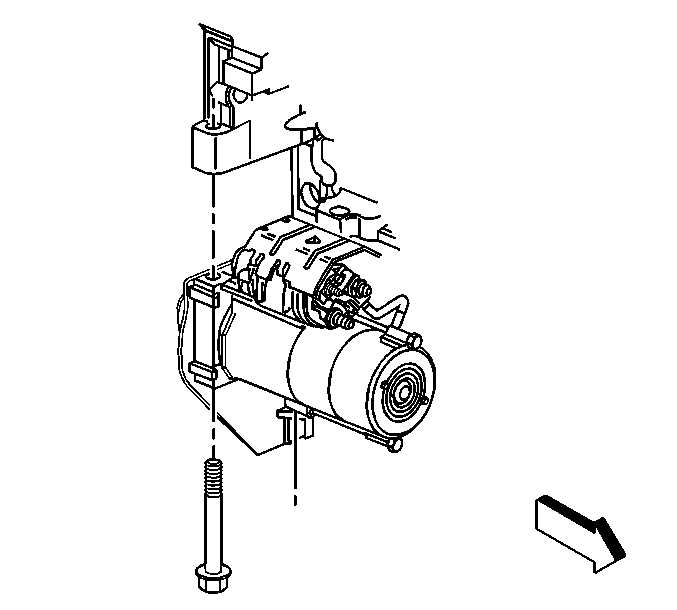
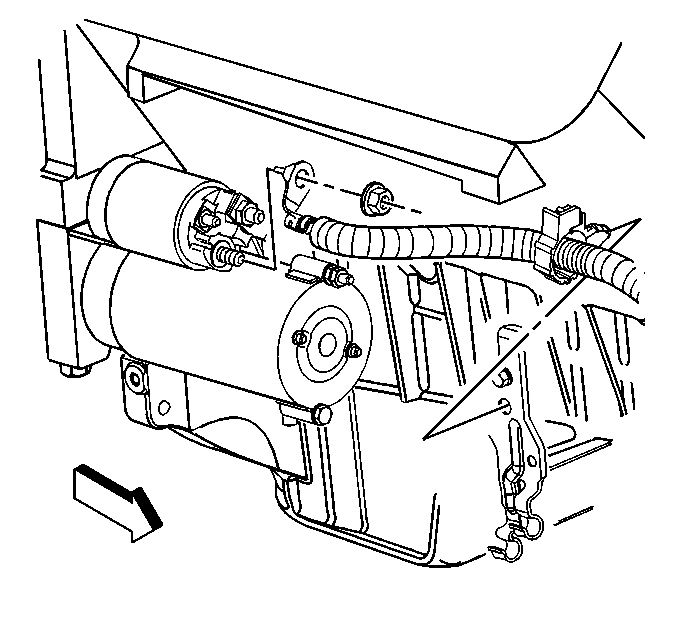
Installation Procedure
- Install the starter to the vehicle.
- Connect the positive battery cable and wiring harness to the starter.
- Install the starter motor mounting bolts.
- Connect the negative battery cable. Refer to Battery Negative Cable Disconnection and Connection .
Notice: Use the correct fastener in the correct location. Replacement fasteners must be the correct part number for that application. Fasteners requiring replacement or fasteners requiring the use of thread locking compound or sealant are identified in the service procedure. Do not use paints, lubricants, or corrosion inhibitors on fasteners or fastener joint surfaces unless specified. These coatings affect fastener torque and joint clamping force and may damage the fastener. Use the correct tightening sequence and specifications when installing fasteners in order to avoid damage to parts and systems.
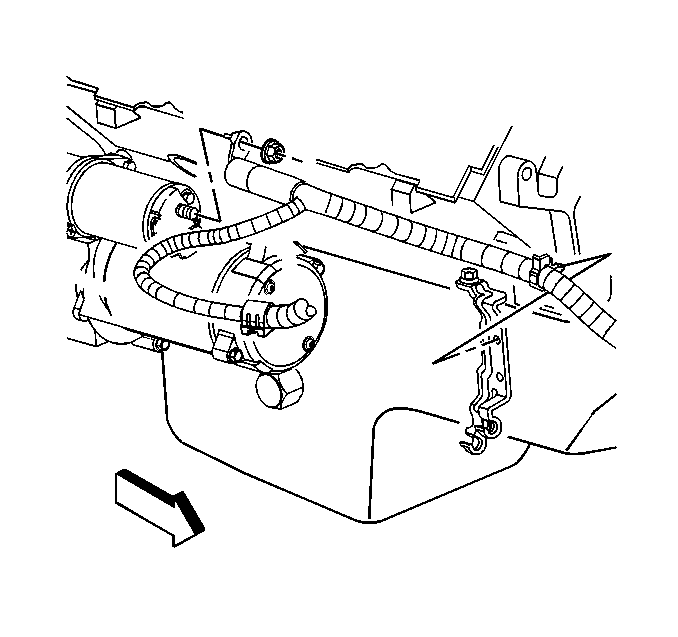
Tighten
Tighten the nut to 16 N·m (12 lb in).

Tighten
Tighten the starter mounting bolts to 43 N·m (32 lb ft).
Starter Replacement 4.8L, 5.3L, and 6.0L Engines
Removal Procedure
- Disconnect the negative battery cable. Refer to Battery Negative Cable Disconnection and Connection .
- Remove the engine oil level indicator tube fasteners and position aside. Refer to Oil Level Indicator and Tube Replacement .
- Raise and suitably support the vehicle. Refer to Lifting and Jacking the Vehicle in General Information.
- Remove the right transmission cover bolt.
- Remove the starter bolts.
- Disconnect the oil level sensor electrical connector.
- Slide the starter forward until the starter clears the transmission.
- Remove the starter solenoid nut (3).
- Remove the starter lead (2) from the solenoid stud.
- Remove the starter lead nut.
- Remove the positive cable from the starter stud.
- Place the starter on a workbench.
- Unsnap the transmission cover from the starter.
- If necessary, remove the starter shield.
Caution: Refer to Battery Disconnect Caution in the Preface section.
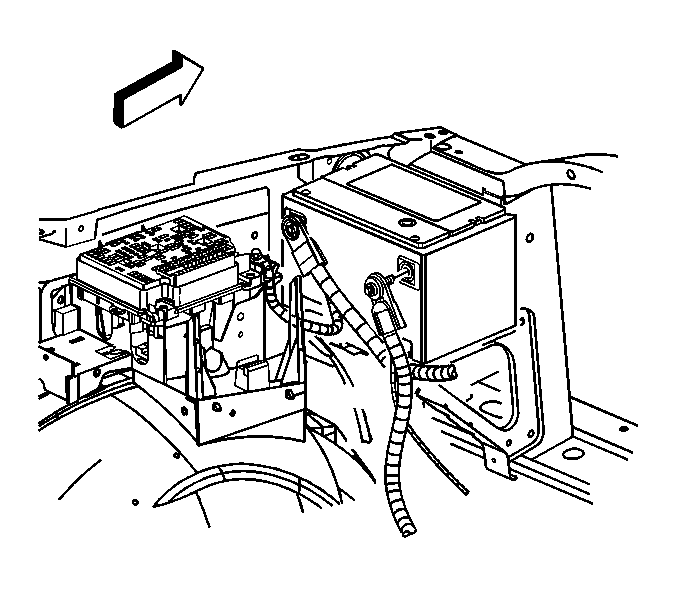
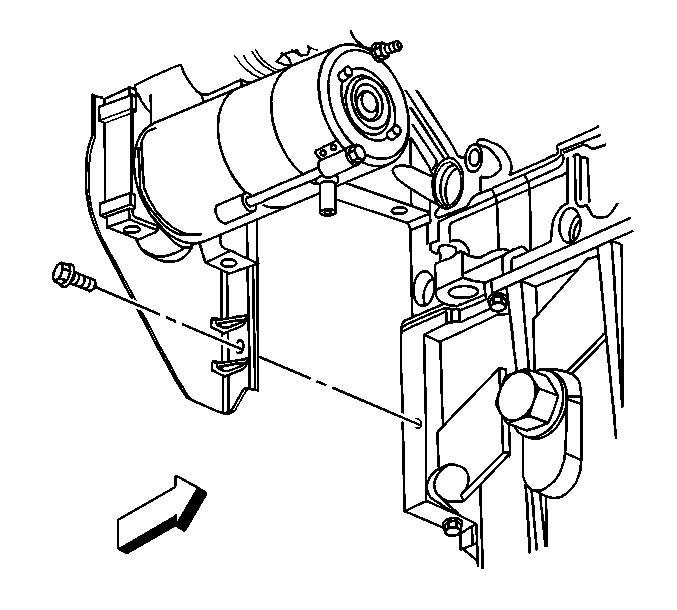

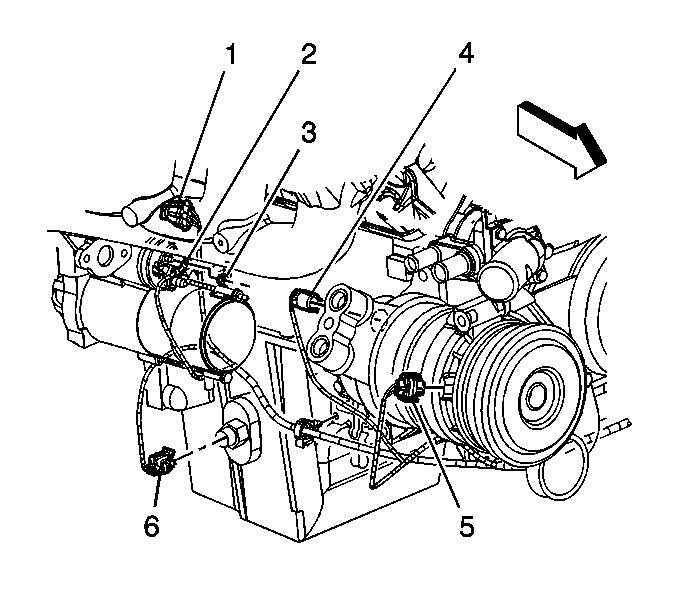

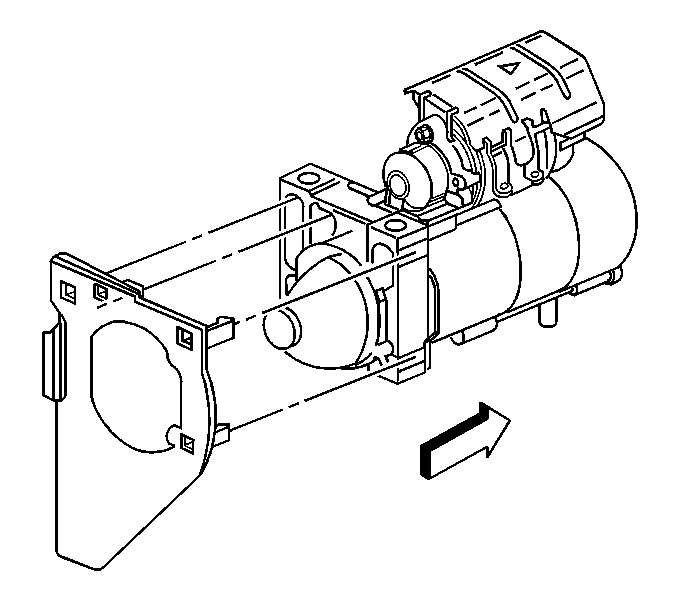
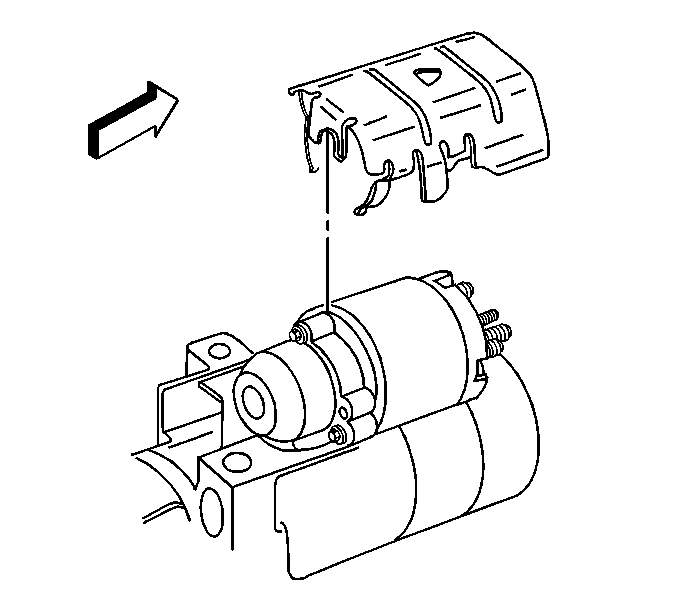
Installation Procedure
- If necessary, install the starter shield.
- Snap the transmission cover to the starter.
- Install the positive cable to the starter stud.
- Install the starter lead nut.
- Install the starter solenoid lead (2) to the solenoid stud.
- Install the starter solenoid nut (3).
- Snap the transmission cover onto the starter.
- Slide the starter rearward.
- Install the starter bolts.
- Connect the oil level sensor electrical connector.
- Install the right transmission cover bolt.
- Lower the vehicle.
- Install the engine oil level indicator tube. Refer to Oil Level Indicator and Tube Replacement .
- Connect the negative battery cable. Refer to Battery Negative Cable Disconnection and Connection .


Notice: Refer to Fastener Notice in the Preface section.

Tighten
Tighten the starter lead nut to 9 N·m (80 lb in).

Tighten
Tighten the starter solenoid nut to 3.4 N·m (30 lb in).

Tighten
Tighten the starter bolts to 50 N·m (37 lb ft).

Tighten
Tighten the transmission cover bolt to 9 N·m (80 lb in).

Starter Replacement 8.1L Engine
Removal Procedure
Caution: Unless directed otherwise, the ignition and start switch must be in the OFF or LOCK position, and all electrical loads must be OFF before servicing any electrical component. Disconnect the negative battery cable to prevent an electrical spark should a tool or equipment come in contact with an exposed electrical terminal. Failure to follow these precautions may result in personal injury and/or damage to the vehicle or its components.
- Disconnect the negative battery cable. Refer to Battery Negative Cable Disconnection and Connection .
- Raise and suitably support the vehicle with safety stands. Refer to Lifting and Jacking the Vehicle in General Information.
- Remove the positive cable nut.
- Remove the positive cable from the starter solenoid.
- Remove the engine harness ground nut from the starter solenoid.
- Remove the engine harness ground (4) from the starter solenoid.
- Remove the starter motor bolts.
- Remove the starter motor.
- Remove the starter heat shield bolts, nut, and shield, if necessary.

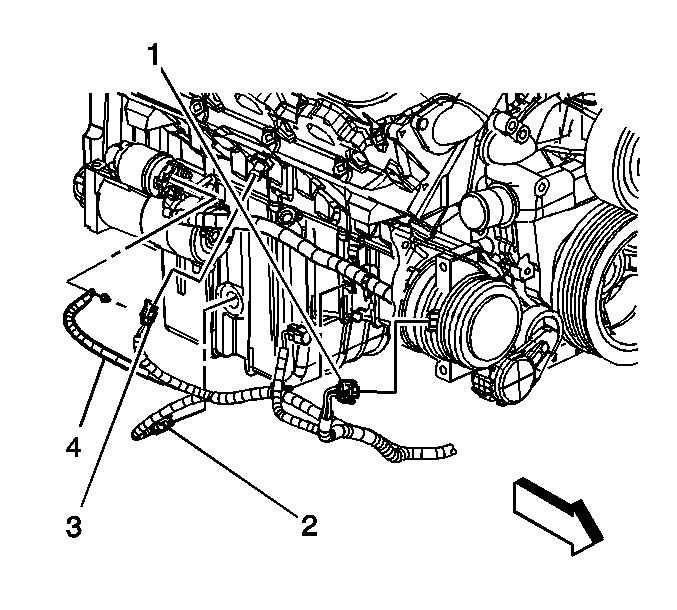
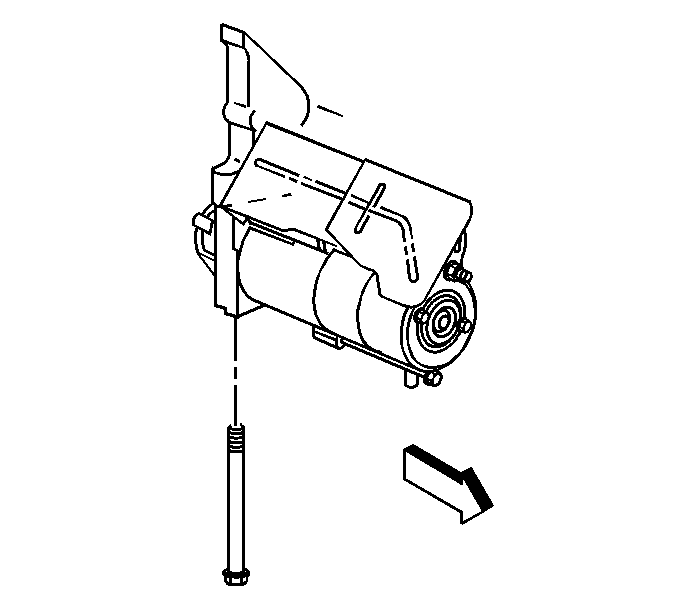
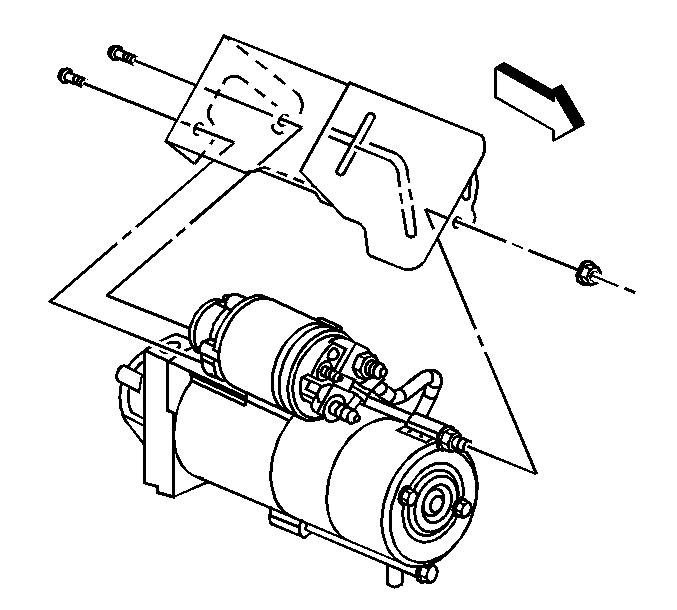
Installation Procedure
- Install the starter heat shield, nut and bolts, if necessary.
- Install the starter motor.
- Install the starter motor bolts.
- Install the engine harness ground (4) to the starter solenoid.
- Install the engine harness ground nut to the starter solenoid.
- Install the positive cable to the starter solenoid.
- Install the positive cable nut.
- Lower the vehicle.
- Connect the negative battery cable. Refer to Battery Negative Cable Disconnection and Connection .

Notice: Use the correct fastener in the correct location. Replacement fasteners must be the correct part number for that application. Fasteners requiring replacement or fasteners requiring the use of thread locking compound or sealant are identified in the service procedure. Do not use paints, lubricants, or corrosion inhibitors on fasteners or fastener joint surfaces unless specified. These coatings affect fastener torque and joint clamping force and may damage the fastener. Use the correct tightening sequence and specifications when installing fasteners in order to avoid damage to parts and systems.
Tighten
| • | Tighten the starter heat shield bolts to 3 N·m (35 lb in). |
| • | Tighten the starter heat shield nut to 5 N·m (44 lb in). |

Tighten
Tighten the starter motor bolts to 50 N·m (37 lb ft).

Tighten
Tighten the engine harness ground nut to 3.4 N·m (30 lb in).

Tighten
Tighten the positive cable nut to 9 N·m (80 lb in).
Starter Replacement 6.6 L Engine
Removal Procedure
- Disconnect both battery negative cables. Refer to Battery Negative Cable Disconnection and Connection .
- Raise the vehicle. Refer to Lifting and Jacking the Vehicle in General Information.
- Remove the right front tire and wheel. Refer to Tire and Wheel Removal and Installation in Tires and Wheels.
- Remove the right front fender wheelhouse inner panel (1).
- Disconnect the turbocharger exhaust pipe. Refer to Exhaust Manifold Pipe Replacement in Engine Exhaust.
- Remove the battery positive cable from the starter motor.
- Remove the solenoid wires.
- Remove the starter motor bolts.
- Remove the starter motor assembly.


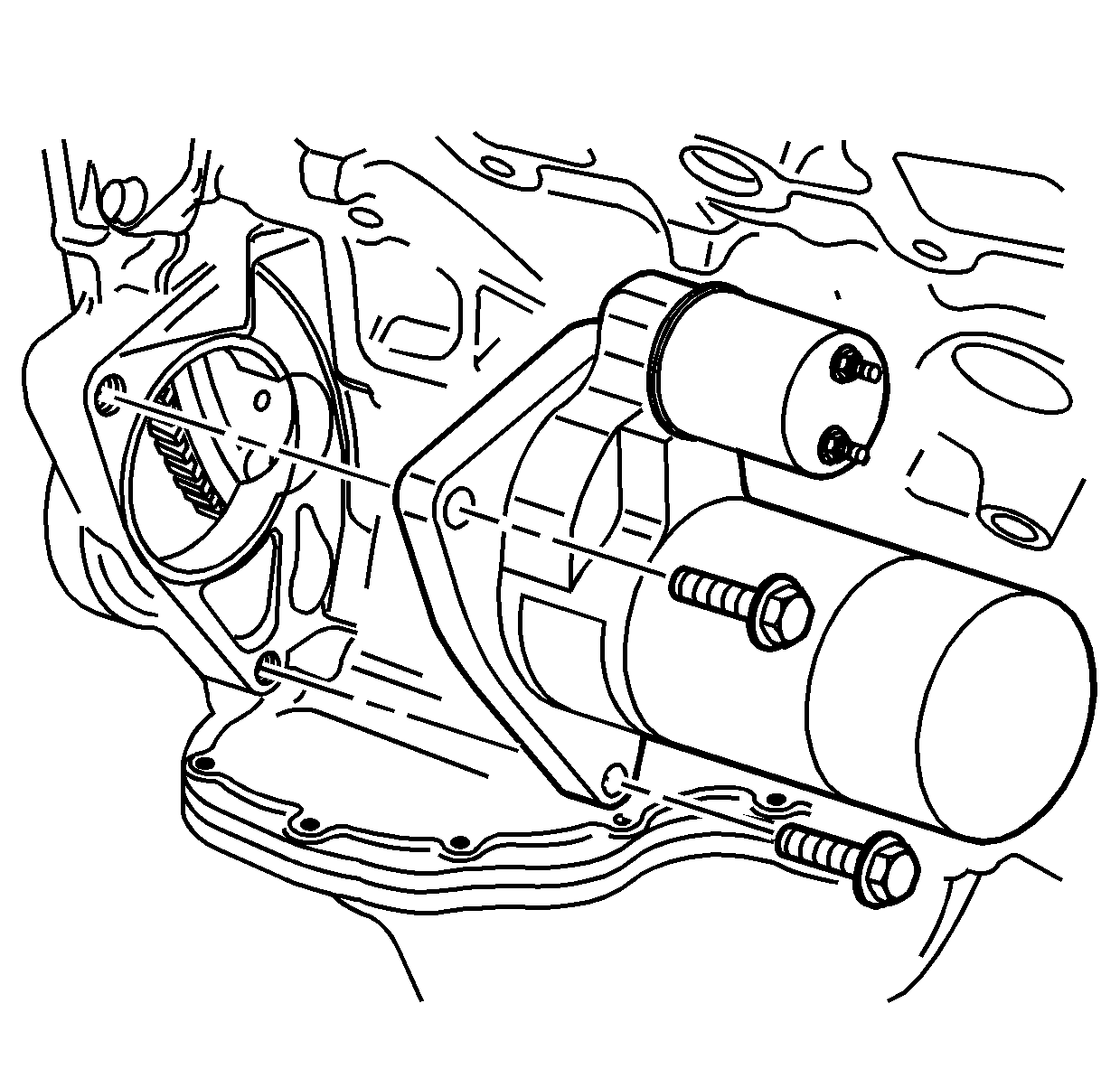
Installation Procedure
- Install the starter motor to the engine rear cover.
- Install the starter motor bolts.
- Install the solenoid wires.
- Install the starter solenoid nut.
- Install the battery positive cable to the solenoid stud.
- Install the battery positive cable nut.
- Connect the turbocharger exhaust pipe. Refer to Exhaust Manifold Pipe Replacement in Engine Exhaust.
- Install the right front fender wheelhouse inner panel (1).
- Install the right front tire and wheel. Refer to Tire and Wheel Removal and Installation in Tires and Wheels.
- Lower the vehicle.
- Connect both battery negative cables. Refer to Battery Negative Cable Disconnection and Connection .

Notice: Refer to Fastener Notice in the Preface section.
Tighten
Tighten the starter bolts to 78 N·m (58 lb ft).

Tighten
Tighten the starter solenoid nut to 3.4 N·m (30 lb in).
Tighten
Tighten the starter battery positive cable nut to 9 N·m (80 lb in).

